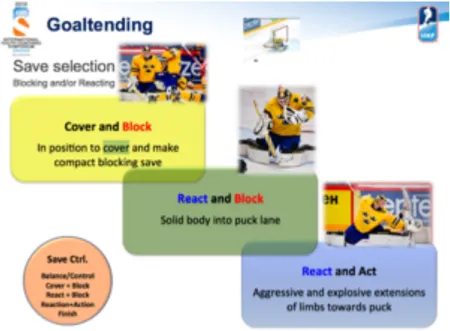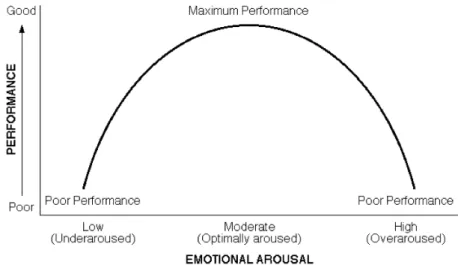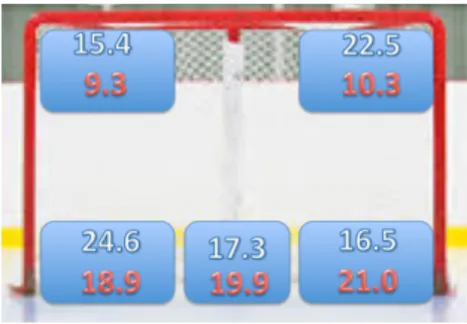The backbone of a hockey team" or "The most important position in sports" are two of many phrases used to describe the goalie's position in the sport of ice hockey. The manual will try to fill avoid that is missing in the hockey development program of the Royal Belgian Ice Hockey Federation.
Studies on Scoring
During the 2003 World Championships, Sumkin and Vourinen found that the bottom of the net was where most goals were scored. The other areas of the net (top corners and middle sides) provided shots of 10.3% or lower.

Sports development Model
Long-Term Athlete Development (LTAD)
Studies have shown that there is a window in which a person needs to learn basic skills. After this window closes, there is a "repercussion" and limitation on the abilities at a later age.

Observational Learning
A goalie development model for Belgium
The Goalie
Save” is the technique or selection of the save used to prevent balls from going into the goal. Post-Save” can be technical or tactical skills such as recovery, ball tracking or rebound control.

Technical Skills
Basic Stance
The stick must be placed flat on the ice in front of the goaltender to cover the five hole across the ice. The blocker must be in front of the goalie instead of touching the block.

Skating and Movement
The trapper must be in front of the goaltender with an open palm facing the shooter and the puck. Instead of alternating drive and support skates, the drive skate mimics the movement with rapid repetition until the goalie reaches the desired distance. The anchor/support skate is the direction in which the goaltender moves, while the opposite skate provides the drive.
Left anchor/ . supporting leg means the goaltender moves to the left while the right skate pushes and vice versa.). This is a skill that allows the goalkeeper to maintain his stance while moving forward and backward. To stop, the goalie may use modified reverse snowplow on one skate or even both skates.
Pad movement
In a situation where the puck is tight to the goalie but is moving short lateral distances, the goalie may choose to stay on his butterfly to maintain net coverage. The goalie simply alternately lifts his block slightly off the ice and "toes" in the direction he's going. Mastery of basic save techniques are critical to the game of goalkeeping as they are skills used to prevent goals.
Paying attention to the details of each technique reduces the chances of getting beat on the first shot as well as controlling the rebound.
Pad saves
Starting in the ready position, the goaltender pounds the ice with his knees while his skates are thrown out so that the pads are facing the shooter. The goalkeeper must rise and challenge if the puck is in the higher zone. One situation, such as a cross, where the goalkeeper is caught at a great distance from the shooter.
As mentioned before, the T push can be used if the goalkeeper has to cover a long distance. In a situation like this, the goalie can move the trapper/blocker and pads higher to block the puck. It can also allow the goalkeeper to cover any rebounds within the range of the stick.

Upper Body Saves
A quick recovery from this technique is crucial as more than likely there will be a rebound and the goaltender will be on the ice after the execution. Instead of using other pieces of equipment to block or deflect shots, the goaltender can easily take away potential rebounds by chasing pucks whenever possible. A properly executed gut trap allows the goalie to eliminate rebounds and gain possession of the puck.
The gut trap can be used while the goalkeeper is on his feet or (going) down in the butterfly. The most common way to use the blocker is to bend the puck into a safe area (corner) where players cannot get a rebound for an immediate shot. Instead, the goalie uses the shots fired at the blocker to hold the puck against the blocker and eliminate rebounds.

Covering the puck
Stick Saves
Similar to a poke check used by a defensive player to knock the puck off the puck carrier's stick. This can be a "throw" of the stick forward toward the puck, or the goaltender can slide his hand back to the edge of his butt before "pushing" the stick into the puck or puck carrier's blade. Usually when a player walks out around the goal with the puck for a layup or pass.
After extending the stick, the goalkeeper swings the stick (flat on the ice) at the puck or the blade of the puck carrier. There may be situations where the sweep check is successful (or unsuccessful) and the puck slides toward the target. In a situation where the goalie is tight on the puck and lying down with the paddle down (i.e. deck, deflections or tips).

Puck Control
The goalkeeper catches the shaft with the net strap closest to the knob/butt end. If the goalie is strong enough, he can hold the stick with just the blocker. The goalkeeper may choose to bounce the ball off the boards (or the back of the goal) to a teammate.
Depending on the speed of the puck and the side it is rimmed in, the goalie has a number of ways to stop the rim. When leaving the crease (to go behind the net), the goalkeeper must start with a T-push. If the puck is controlled from a long shot, the goalie can move the puck (with one hand) to the side of the goal or behind it, if there is time.

Positioning
If the puck is recovered from a rim, the goaltender must leave the puck behind the net, preferably away from the end boards and the back of the goal frame. The angle of determines how much the goalkeeper's equipment covers the puck's trajectory to the net in a standing position. The goalie who "plays his corners" tries to get as much of his equipment in the way of the puck's trajectory to prevent it from going into the goal.
Due to the speed of the puck, the size of the goaltending equipment and its mobility, the goaltender cannot follow the puck even by a few inches. The horizontal angle where the goalkeeper should stand is fairly simple. holes" the same, the goalie must stand from the middle of the net then with the puck. Cruciate for close shots, as the goaltender must bring his glove as close to the puck as possible.
Tactical Skills
Individual Tactics
One option for the ball carrier is to make the goalkeeper move laterally to expose holes in his coverage. In tight situations, the goalie must be aggressive (with poke checks) while maintaining good net coverage. The goalkeeper must stay tight on the post and hit the balls that come into his range.
The goalie must stay square with the puck and maintain net coverage. situations meaning that moves along the ice are most effective. The first rule in this situation is that the goaltender's body must face the ice. A screener is a player who stands in the path of the goaltender and from a full view of the puck.

Combined Tactics
Other types of odd-man attacks are played the same way with additional situations to play. In the 3-on-1, a vertical pass (in the form of a drop) can take place to F3 (who is the third attacker entering the zone). In this case, the goalkeeper simply adjusts by moving with the puck and challenging the puck.
Practice Planning
A study by Carroll and Bandura (1985) on simultaneous monitoring of performance and feedback found that delayed monitoring (after 100 seconds) made it more difficult for the learner to correct and learn a motor skill. Allow the goalie time and space to do exercises that help improve goalie-specific skating. Coaches should always keep the intensity of the exercises in mind when planning the practice for the goalkeeper.
30 minutes of consecutive shooting practice followed by 30 minutes of inactivity is not a good pace for the goalkeeper. Overexertion of the goalkeeper in the warm-up will most likely develop bad habits in stance, save and recovery techniques.

Mental Training
You can set goals for many things such as a season, games, and even training sessions. Clear goals let the goalkeeper know why they are doing something rather than just going through the motions. A goalkeeper can be in goal for 60 minutes or more and has to control his emotions.
Thinking about allowing a goal before it would help can be distracting and can eventually lead to the goal. A goaltender must practice a mental exercise by executing each technique (or play) with confidence and efficiency. Start by breathing and relaxing, this will improve the quality and clarity of the image.

Empirical Learning
The report was the basis of the manual was a review and recommendations I made on goal development in Belgium during my internship. The keynote widget in the ibook authoring software allowed for more interaction in the form of the Belgian goalkeeper development model. These were the important parts of the manual that set it apart from other coaching manuals.
The purpose of the manual was to provide knowledge about skills needed to play the goalie position in the sport of hockey. The skills discussed in the manual are technical, tactical and also look at practice planning for coaches and the mental aspect of the position. Part of the idea of creating a manual like this was that it allowed information to be updated.





